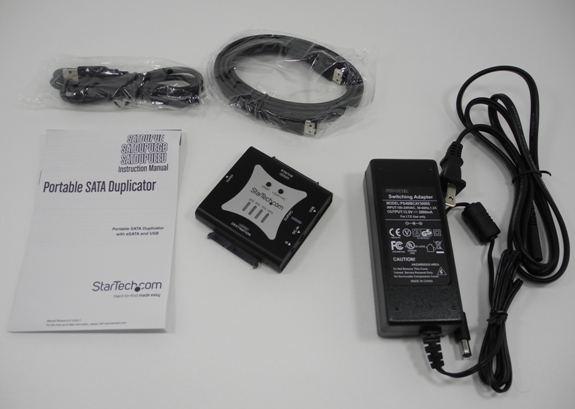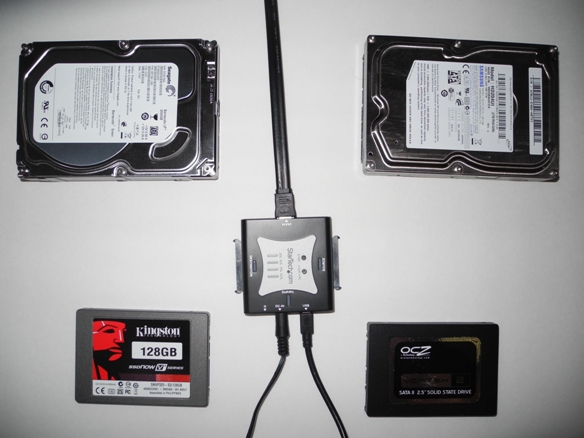StarTech.com Portable SATA Duplicator & USB / eSATA Dock Review
by Ganesh T S on September 6, 2011 6:50 PM EST- Posted in
- Gadgets
The SATDUPUE package contained the following:
- Portable SATA duplicator / dock
- 36W power adapter
- eSATA - eSATA cable
- USB 2.0 A Male to Mini-B 5 pin Male cable
- Instruction manual
Before getting into the test setup and benchmarking process, it is important to understand the usage and limitations of the product.
In the dock mode (default, green mode status LED), connecting two drives will result in a JBOD configuration (2 distinct disks visible to the PC). However, this is only through the USB port. If seen through the eSATA port, only the drive connected to the destination is seen (unless the PC's eSATA port supports port multipliers). When both USB and eSATA are connected, USB takes preference.
The product can be put into the duplicator mode (red mode status LED) by keeping the mode button pressed for 3 seconds. In this mode, the drive connected to the destination must be of equal or higher capacity compared to the drive connected to the source port. In our testing, we made sure that there was no EISA partition in the source drives. StarTech.com specifically mentions that the EISA partition must be removed prior to duplication.
Our test setup consisted of the following:
- SATDUPUE
- Seagate Barracuda LP 2000 GB 3.5" Hard Drive [ ST2000DL003 5900 rpm 64MB ]
- Samsung EcoGreen 2 TB 3.5" Hard Drive [ HD204UI 5400 rpm 32 MB ]
- OCZ Vertex 2 OCZSSD2-2VTX120G 2.5" 120GB SSD
- Kingston SSDNow V+ Series SNVP325-S2/128GB 2.5" 128GB SSD
For testing the dock functionality, the OCZ Vertex 2 drive was hooked up to a 6 Gbps SATA port in the ASRock CoreHT 252B's HM65 based motherboard as a secondary drive. The eSATA port in the CoreHT 252B unfortunately doesn't support the port multiplier function.
Two sets of tests were performed, one in DOCK mode and the other in DUPLICATOR mode. All the tests involved transfer of the HQV 2.0 Benchmark Blu-ray folder backup (11.37 GB Blu-ray folder structure) using the robocopy command in mirror mode. While the stress was on transfer rate measurements, the duplicator mode also offered interesting insights into the power consumption and temperature factors.
In the next section, we will look at the benchmark results and present our conclusions.


















36 Comments
View All Comments
TrackSmart - Tuesday, September 6, 2011 - link
Neat product. There are a number of times that I could have used this when helping family members or friends transfer data to a new HDD or computer. Unfortunately, my experience with HDD enclosures from companies StarTech, Bytecc, etc has me wondering if it would turn into an $80 paperweight after using it a few times. Your comments about fragility certainly don't bode well either.Googer - Thursday, September 8, 2011 - link
That's goes along with my concern.This duplicator may be fast, but more importantly is it ACCURATE and dependable? Can it clone a whole TB drive with out errors or quitting?
GeorgeH - Tuesday, September 6, 2011 - link
I use devices similar to this and they're definitely nice to have, but on the whole I've found their reliability to be pretty hit and miss. At this point my first instinct is to use a power brick->SATA power adapter and a SATA<-<eSATA cable, then try something like this through USB if that isn't feasible.From my perspective that's actually the weakest point of this gadget - I'd recommend getting a SATA power extension cable and a SATA<->eSATA cable as well. That way if the data part fails to work you can still use this device as a power supply and connect a drive directly to an eSATA port.
ckryan - Tuesday, September 6, 2011 - link
I was just cloning some SSDs now.I actually kinda wish I had this at the moment. Lately I've been using cloning as a primary backup method, and I could see this as being very useful to me... Not $80 useful, but more like $50 useful.
ganeshts - Tuesday, September 6, 2011 - link
It is available on TigerDirect for the price you mention.The Bytecc model (not sure if it uses the same chip / has the same performance) is available in both Microelectronics and Frys for less than $40. (Also on some online websites)
Reikon - Tuesday, September 6, 2011 - link
Another poor article from Anandtech. Seems like they keep increasing. Don't be like poor quality sites where reviews are half quotes/info verbatim directly from the manufacturer with no added insight. And do we really need to a bulleted list of pros and cons? Seemed like the site was above doing stuff like that, not to mention all the info is basically right above it on the same page.Jedi2155 - Tuesday, September 6, 2011 - link
While the number of insights is limited (i.e. it performed better than advertised), it did provide some of the usual Anandtech qualities such as overview of system i/o of how the unit operates. This is in contrary to most poor reviews where the reviewer merely discuses usability and performance. I'd say its an "adequate" review while not up to Anand's usual in-depth article, it definitely does provide some useful details about a product that is usually reviewed by far poorer websites.FH123 - Tuesday, September 6, 2011 - link
I must confess I haven't read this article, but I would agree there's no point in repeating features or other information you can get elsewhere. On the other hand I've had multiple AKASA external drive bays that plain didn't work, causing reproducible CRC errors reading known good Ghost images. This can be very insidious. A colleague of mine used his AKASA enclosure to play MP3s and, while he noticed dropouts in the music, never put that down to the enclosure. A different, Sharkoon, adapter of mine, while not introducing errors, hangs every so often, which is a big deal when you're imaging a disk for several hours. A lot of these products seem to be made with JMicron chipsets, the same company that produced the early SSD chipsets that would cause drives to freeze. Anand's investigations of such issues are some of the most valuable insights that I come here for.I also own a StarTech eSata dock that has a different issue altogether, a strong acrid smell from manufacturing that just won't go away. Wasn't planning on buying from them again until I get confirmation of neutral odor ;-).
ganeshts - Tuesday, September 6, 2011 - link
Reikon,Thanks for the feedback. In my opinion, the list of pros and cons make an ideal summary of the piece for people reading the review in a hurry.
This is a very basic gadget. Can you let me know what more insight can be provided into this basic bridge device? I am open to suggestions.
Reikon - Wednesday, September 7, 2011 - link
I'm not saying there's more insight to provide on this gadget. I'm saying we don't need information/quotes directly from the manufacturer if there's nothing insightful you can say about it. It just looks like padding for the review -- a technique that lower quality sites like to use. I mean seriously, do I need to know it comes with the instruction manual? I mean sure, if it doesn't come with one and isn't intuitive, mention it. Otherwise, I don't think people care.As for your pro/con list, it seems to fall into the trap lots of sites make nowadays that cater to the tl;dr crowd. A summary paragraph is much more professional. Your list includes a lot of obvious things or things mention right above it anyway. For example, "Multipurpose gadget with both eSATA / USB dock as well as clone mode." That info is already in the product name! Most of the info is already in the tables above or doesn't really need to be stated. You can just write a short summary paragraph about its strengths and weaknesses instead of padding out a list.